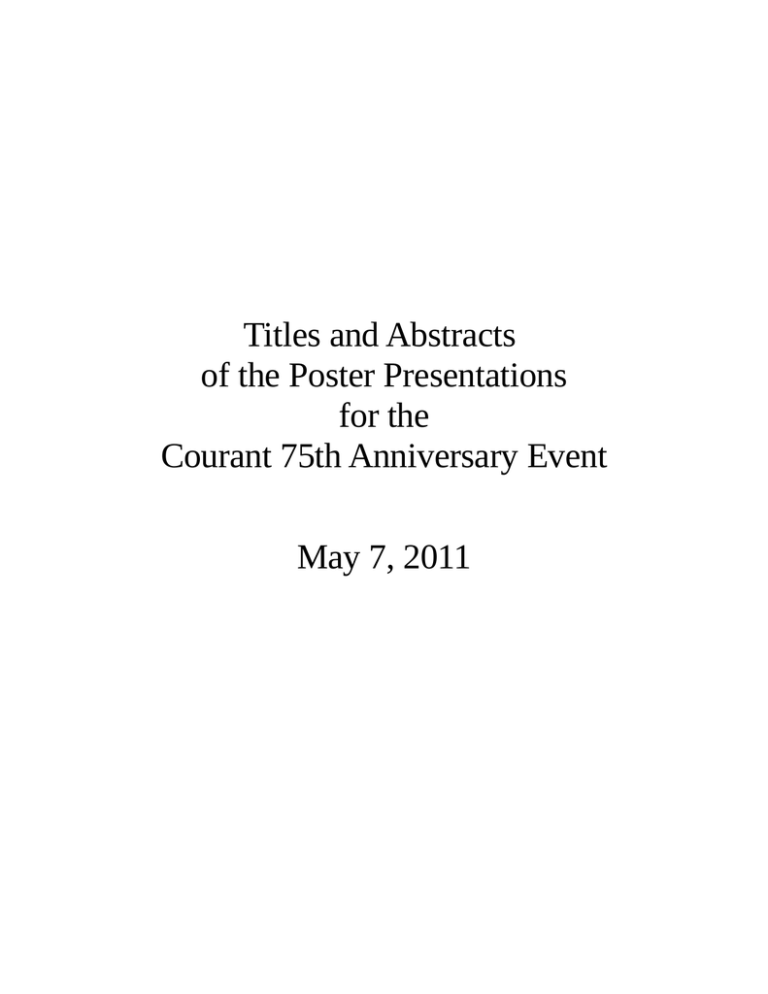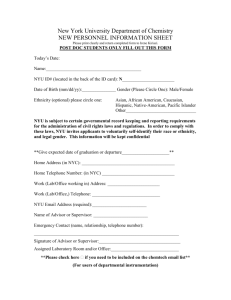Document 10902916
advertisement

Metric-induced wrinkling of an elastic thin film
and
Wrinkles as a relaxation of compressive stresses
in annular thin films
Peter Bella
April 7, 2011
Abstract
We study the wrinkling of a thin elastic sheet caused by a prescribed nonEuclidean metric. This is a model problem for the folding patterns seen, e.g., in
torn plastic membranes and the leaves of plants. Following the lead of other authors
we adopt a variational viewpoint, according to which the wrinkling is driven by
minimization of an elastic energy subject to appropriate constraints and boundary
conditions. Our main goal is to identify the scaling law of the minimum energy as
the thickness of the sheet tends to zero. This requires proving an upper bound and
a lower bound that scale the same way. The upper bound is relatively easy, since
nature gives us a hint. The lower bound is more subtle, since it must be ansatz-free.
Abstract
It is well known that elastic sheets loaded in tension will wrinkle, with the length
scale of wrinkles tending to zero with vanishing thickness of the sheet [Cerda and
Mahadevan, Phys. Rev. Lett. 90, 074302 (2003)]. We give the first mathematically
rigorous analysis of such a problem. Since our methods require an explicit understanding of the underlying (convex) relaxed problem, we focus on the wrinkling
of an annular sheet loaded in the radial direction [Davidovitch et al, arxiv 2010].
While our analysis is for that particular problem, our variational viewpoint should
be useful more generally. Our main achievement is identification of the scaling law
of the minimum energy as the thickness of the sheet tends to zero. This requires
proving an upper bound and a lower bound that scale the same way. We prove
both bounds first in a simplified Kirchhoff-Love setting and then in the nonlinear
three-dimensional setting. To obtain the optimal upper bound, we need to adjust a
naive construction (one family of wrinkles superimposed on the planar deformation)
by introducing cascades of wrinkles.
1
Nodal Sets of Stekloff Eigenfunctions
Katarı́na Bellová
April 8, 2011
Abstract
We study the nodal sets of Stekloff eigenfunctions, i. e. solutions of ∆u = 0
n
in Ω, ∂u
∂ν = λu on ∂Ω, where Ω is a sufficiently smooth domain in R . Our goal
is to estimate the Hausdorff (n − 2)-dimensional measure of the nodal set on the
boundary, Hn−2 ({x ∈ ∂Ω : u(x) = 0}), in terms of the eigenvalue λ. In case that Ω
is an analytic domain, we aim for a polynomial bound in λ. The non-analytic case
is more subtle and requires the use of additional compactness methods, by which
we only get a non-explicit bound.
R
R
Our main tool is a generalization of the frequency N (r) = r Br (a) |∇u|2 / ∂Br (a) u2 .
We use the monotonicity of N , and show a doubling property ||u||L2 (B2R (a)∩∂Ω) ≤
C(N )||u||L2 (BR (a)∩∂Ω) for a ∈ ∂Ω.
This is a work in progress.
1
!
∀#∀∃% ∃!! ∃ %
& ∃ ∋&∃% ( ∃&∃)∋∋!
! )∗+,−)∗.)∋∋!! )/0+,−)/0.
∀ & ∋& ∋∋!
!∃ (∃% 1 ∋∋
∋∋2!1! ∋3 ∋ ! %∋& ∃ ∃ %! %%∃! ,−)∗,−)
/01∋∃& %%456∀∀7∃!&∋!∃!
∃ , !& %∃%∀∀7
∃ ∃!8 & (%
∋∃ & %% ! ∋ 97 ∃&!&
! !1 &! ∋,−)∗ %%9 %% ,−)∗,−)/0∃% ∃ ∃!&!%
!∋ ∀∀7:% %) ∃ ∋ 1∃∋ ∋∃
∋% %∃%!%!∋ ∀∀7
∃% ∃ ∋ + .(∋
∋ ∃!∋!%) ∋%%!∋!,−)∗
∋ ∀∀7∃ ∃!
8 ∃%∃&&97, ,−)/0
%% ∀∀7;,−)/0 %% %∃)
8%& ∀∀7∃ ∃!,−)∗<%
∃ %% %!∋ ∀∀7 ∃ ∋% %% ! ∋ ∃∋ ∃ 1∃∋& %∃ % & (1∃∋
∋! ,−)∗,−)/0 %%∃% ∃!
∃ &!%∀∀7∀ %∋!∃1∃
& ∋∋∋ ∃ %%( #∋∃∃ ! ∋ % %∋∃ % ∃ ∃ !∀#∃%&
∋(!!)#∃∗&
∋+!
!∀,)!−. /
−
−
00
−11−
1−
−
2
−1−3−1−
!∀#∃
%&∃
&∋%∋
!(!)(∗
+∋
!∀∋%∃∃
∃!!,
∀(!
+∋!∋∀
∋
∋∋
, !∃∃
∋
!
!!∋%#
!
!
!∋
!!!!
!∃
,
!∋%∋!
∋
!
−∋
!∃∃∋%
!
−−
−!∋!,&∃
#
!∀
∋∃+
∋
∋
∋∋
!.∀
!!!
∋
!!∃
∃+,&
!
!∋∀∋%∃∃∃
∋∃∋
!&∃!∋
!∀∃∃∃!∃
,
Object detection, image segmentation and scenes parsing using
convolutional network
Benoit Corda, Clément Farabet and Yann LeCun
Computation and Biological Learning Lab, NYU
Scene parsing is the task of assigning a class label to each pixel of an image. Although very similar to
image segmentation, the scene parsing requires an understanding of high-level relationship between objects
appearing on the scene. Whereas the segmentation goal is to create cluster of pixels that belongs to the same
object. The scene parsing not only needs to groups similar things together, but also must recognize the
category of the groups and understand their spatial dependencies.
Here we propose an inference model based on convolutional neural network for scene parsing. The
power of this approach has two fold, at the same time the model can provide an object detection system and
an image segmentation of the input image.
Inspired by previous work from Grangier et al.[1], we used a subset of the LabelMe dataset (http://
people.csail.mit.edu/torralba/benchmarks/) that contains about 3000 images of spanish cities to train our
model and we removed 10% of the set for validation. From the thousand classes we kept the twenty most
frequent and merge the objects that were conceptually similar (e.g. car and truck). All the images were first
resized to 500 × 375, then 400 million patches were randomly sampled to produce a 20 × 1e8 × N × N
tensor where the first dimension indexes the classes, the second indexes patches of which the center pixel
belongs to the corresponding class, and the last two dimensions are the height and width of the patch.
The training is done in a greedy fashion using stochastic gradient descent (SGD). First we used a
model called CN1 similar to LeNet-5 [2] with 3 convolutional layers with small filters (5x5). After
convergence we increase the size of the filters to 9x9 (model CN2), and finally we add a fourth
convolutional layer with the same filter size 9x9 (model CN3). With this protocol, we managed to get our
best model to reach more than 72% of pixel accuracy (cf. example below).
Street scene that the model never saw before.
Output of the modelʼs classification
[1] D. Grangier, L. Bottou, and R. Collobert. Deep convolutional networks for scene parsing. ICML 2009 Deep Learn- ing
Workshop, June 2009
[2] Y. LeCun, F.-J. Huang, and L. Bottou. Learning methods for generic object recognition with invariance to pose and lighting.
In Proceedings of CVPR’04. IEEE Press, 2004
!∀#
∃%&∋%()∗!
+#,!−!.!
∗/∗0∗1+23+456−−(∗6&∋6()
( (∗(.7
!(!∗
8!
99.
!∗!!
!,∗!.∗∗∗:;
<(.∗
((!!∗!
!!.=(!,>∗?
∀!
(+!−.#∗!
!∗.
!∗∗!,∗
<.
%&∋%)#.∃.≅>.?.∀ΑΒ∗∗
!ΧΑ
6&∋6)/.0∗>.?.∀ΑΒ∆∗4?(∗<
#ΧΑΕ(6%Φ%+6ΓΓΗ−.
6Ιϑ:6ϑΚΑΑ
!
∀
#
#∃
%&
%&
∋
(
#
∃
(
# #
#
()
#
(
#∗
(
#
+ (
)
(
!
!∀#
∃
%&∃
∋#∋∃!∀#
%!∋#
(#(%%!#%
%∀)#∗#+
∃,%
!∀−#%!
∃∃
%!#
∃#∀.
!∃!##!###
∀/#∃∀
!∀
#!∀##∀
∀∃%∀& !
!∋
!∀∀∀
∃
(!∀) ∗!!
∀∀
∀∀+#
!∀∃∃&,
+∀!∀+∀
!∀∀
%!
∀∃−.+∀
!
/0
./∋#!∀#&∃
!11
#∀!∀∀
.#/
∀∀+∀ !∀!2
3!!∀!∀!
!
!4+∀∀∀
!
+∀!
&
∃∀∀!5!∀
∃6∀ #&!∀
!7
∀!!∀
+∀#∀∀!!
!#!+∀
#!8
#2∀9∃%#
∀6+&
∃
#
!!
!∀
∀ #∃%&∋(
)∗
! ∀#+, ∀
) #!∀
)
#−,
,
., # ,#
#)
.∀∋( , #
!∀
#
!!
∃∀# %
&∀∀%∀#∋∀
&∀
∀(!
# ∀
∃!
(
)
%∀
#
!∀#
#####∃
##%
%∃&∋
##((
%
#()∗+,)(%∃&
%#(##
∃
AN ANALYSIS OF THE CRITICAL POINTS OF THE PROPELLER
PROBLEM
STEVEN HEILMAN, AUKOSH JAGANNATH, AND ASSAF NAOR
Abstract. After proving a generalization of the semidefinite Grothendieck inequality, Khot
and Naor conjectured a value for the inequality’s optimal constant. These authors also reduced the calculation of this constant to a finite dimensional geometric optimization problem. For the first nontrivial case, we prove this conjecture by reducing to an isoperimetric
problem on the sphere and then using a numerical computation.
v1
v1
θ13
Θ21,13
v3
θ12
v2 θ23
v3
v2
v4
v4
(a)
(b)
Figure 0.1. (a) Spherical triangle constructed with three great circles (b)
Partition of the sphere into four spherical triangles. We need to optimize the
sum of the squared lengths of a partition as shown.
Courant Institute, New York University, New York NY 10012
E-mail address: heilman@cims.nyu.edu
E-mail address: asj260@nyu.edu
E-mail address: naor@cims.nyu.edu
1
{fig1}
!∀
# ∃
% ∃
&!∀∋
!!!
!∋&
∋∋
(!
∀
∋
)∋
&
!∋
∋)
!∀
!
!∀
FAST DIRECT SOLVERS BY MULTILEVEL MATRIX COMPRESSION
KENNETH L. HO
We present a fast direct solver for structured linear systems based on the hierarchical application of the
interpolative decomposition. The structure imposed on the system matrix is that, up to permutation, there
is a block tree on the rows and columns such that at each level of the tree, the submatrix corresponding
to each row or column block, possibly with the diagonal block deleted, is low-rank. This describes, e.g.,
Laplace-type (1/r) interactions between points in space, sorted according to an octree ordering. We use
the interpolative decomposition to recursively compress each block by identifying row or column skeletons,
which define a subblock of near-optimal rank from which the entire block can be reconstructed, by merging
and compressing the skeletons at the previous level. This multilevel procedure computes a compressed
representation of the matrix, which allows for efficient storage, fast matrix-vector multiplication, and fast
matrix factorization and inverse application via embedding into a highly structured sparse matrix.
For boundary integral systems with non-oscillatory kernels satisfying Green’s identity, e.g., Laplace,
Yukawa, or low-frequency Helmholtz, the solver has complexity O(N ) in 2D and O(N log N ) in 3D. As
a numerical example, the Laplace potential interaction matrix between N = 217 = 131072 charges equispaced on the unit circle can be compressed to nine digits in 13 s on a modern laptop, applied in 0.07
s, factored in 7 s, and its inverse applied in 0.1 s. Ignoring precomputation, the solution time is more
than an order of magnitude less than that of fast iterative methods based on, e.g., GMRES driven by fast
matrix-vector products using the FMM.
We expect our work to apply widely to many problems in science and engineering, particularly in solving
systems with singular geometries, simulating dynamics in fixed domains, or in the context of design, where
many similar systems must be solved.
This is joint work with Leslie Greengard and Zydrunas Gimbutas.
E-mail address: ho@courant.nyu.edu
1
Automated Detection of Diabetic Retinopathy
using an Artificial Neural Network
Angjoo Kim, Rob Fergus, Nathan Silberman
April 8, 2011
Diabetic retinopathy, the most common eye disorder caused by diabetes,
is the primary cause of blindness in America and over 99% of cases in India.
It is caused by changes in the blood vessels of the retina, where sometimes
blood vessels may swell, leak fluid, and block vision. Unfortunately there is
no known cure for diabetic retinopathy and early detection of the disease is
essential in preventing blindness.
The purpose of this study was to extend the existing work in developing an automated detection system for diabetic retinopathy. Initial efforts
towards building such a system used a range of computer vision techniques
along with a Support Vector Machine (SVM) classifier trained to recognize
indicators of retinopathy in retinal images.
This study used an Artificial Nerual Network (ANN) classifier instead
of the SVM classifier in hopes of improving the performance of the system.
An ANN with back propagation was implemented and trained to recognize
exudates, bright yellow spots of fat deposits in the retina, which in turn
lead to blood clots and spillage. The training set consisted of SIFT features
obtained from 33 retinal images with pixel-level labels marked by ophthalmologists at NYU.
The effects of different methods of selecting training features and different network variables were assessed. The current accuracy of the ANN
classifier does not improve that of the SVM classifier. However, there are
immediate improvements in the training process and evaluation of the classified data that could potentially improve the overall accuracy the system
with a neural network.
1
Glucose Regulation in Diabetes
Samantha Lozada, Mathematics
Mentors: Dr. Charles S. Peskin, Mathematics
Thomas Fai, Mathematics
Complicated and extensive models of glucose regulation, involving several
variables, have been developed over the years. Our research specifically focuses on the
feedback loop between insulin and glucagon. Although our model is simpler than a
model including state variables such as non-esterified fatty acids concentration in the
blood plasma, β-cell mass, TAG content of lipocytes, and/or leptin concentrations in the
blood plasma, we are still able to simulate most of the key effects of diabetes and other
health problems on glucose regulation; such as, hyperglycemia, hyperinsulinism, and
insulin shock (hypoglycemia). We are even able to simulate eating a bowl of vanilla ice
cream!
!∀
∀∀
#∃!
% !∀∀
#!! ∀∀∃
∀!! ∃∀!∀# &∃∀%∀
∀∀∃#
∋∃∀∀!
∃∀#!∀
∀%!∀ (!)(
)#∗ ∃ ∀
!∃ ∀!#+
∀∃∀∀
#
!∀#
∃
∃
% !&∃
∋(%!)&
∋∗+∃∃
,
∃∗−
∗∃
∗+∃ !−
∋∗
,∃
!
∃−
∃∋−∋∗
∋
.
,
∋∃
%&!)
−
∃∃∃−
∃∋
,
−
!)
∋(
∃
∃
/ !∃
∗∋
−
∃−
,
∗
∃
∃
∋−(∗∋,
/∃
∃
∗∃
!∀
−∋ / ∗
∃∃∋
∃
−
∃
!)%∃
∗∗
&,
#∃∋∗
∃
∗
∃
−∋ / ∋,
!)/0∃
−
/
∃∃
∗
,
∃
∃−∋
.
∗∋,
−
−∋−
−∋−
∃
1,
∃
∗∃
∃
,
Two-dimensional slope limiting for embedded boundary grids
Sandra May
Many two-dimensional, second-order accurate finite volume methods are based on the following 3 steps:
1. Construct a (limited) linear polynomial in every cell out of the given cell averages (unij ).
2. Calculate the fluxes through the cell edges using the linear polynomial.
3. Update the cell averages to (un+1
ij ) using the fluxes through the edges.
In Step 1, a limiter is needed which adjusts the slope appropriately. The limiter prevents overshoots
and oscillations that arise at discontinuities, as well as maintaining positivity, since for example if pressure
becomes negative your code will crash. Limiters in one dimension are very well understood, see e.g. the
paper by Sweby [Swe84]. In two dimensions for rectangular grids a one-dimensional limiter is usually applied
in the x and y direction separately. This is approach is very straightforward to realize and usually works
well. However, this splitting of x and y components of the gradient relies on the cell edges being aligned
with the coordinate axes.
On non-rectangular grids a two-dimensional limiter is much more difficult to realize – especially for
embedded boundary grids with ‘cut cells’, the motivation for this work. By ‘cut cell’ we refer to the cells
which arise around the boundary of a solid object which is cut out of a background Cartesian grid. These
cells vary considerably in terms of size and structure. The standard approach for these cells, or more
generally for unstructured meshes, uses a scalar limiter, where the x and y components are decreased by a
scalar until there are no overshoots (possibly the scalar is zero). Our approach for limiting is based on the
work by Berger, Aftosmis, and Murman [BAM05]. There, the authors develop the idea of formulating the
limiter as an optimization problem: retain as much of the unlimited gradient as possible while fulfilling some
monotonicity conditions in order to avoid overshoot. This allows us to use different scaling factors for the x
and y components of the gradient in order to minimize diffusion.
We have worked on different formulations for the objective function and the constraints as well as on
different ways to solve the resulting optimization problem. We currently formulate this as a linear programmming problem and use the all-inequality Simplex method for its solution. We show results where the error
using our new limiter compared to using a scalar limiter has been reduced significantly. We are currently
working on additional test problems as well as extensions to three dimensions. We will also test our limiter
on general unstructured grids.
References
[BAM05] M. Berger, M. J. Aftosmis, and S. M. Murman. Analysis of slope limiters on irregular grids. In
43rd AIAA Aerospace Sciences Meeting, Reno, NV, 2005. Paper AIAA 2005-0490.
[Swe84]
R. K. Sweby. High resolution schemes using flux limiters for hyperbolic conservation laws. SIAM
J. Numer. Anal, 21:995–1011, 1984.
Scoring-and-Unfolding Trimmed Tree Assembler:
Algorithms for Assembling Genome Sequences
Accurately and Efficiently
Giuseppe Narzisi and Bud Mishra
Courant Institute of Mathematical Sciences
New York University
Aprile 2011
Abstract
Mired by its connection to a well known N P-complete combinatorial optimization problem — namely, the Shortest Common Superstring Problem (SCSP) —
historically, the whole-genome sequence assembly (WGSA) problem has been
assumed to be amenable only to greedy and heuristic methods. By placing efficiency as their first priority, these methods opted to rely only on local searches,
and are thus inherently approximate, ambiguous or error-prone, especially, for
genomes with complex structures. Furthermore, since choice of the best heuristics depended critically on the properties/errors of the input data and the available long range information, these approaches hindered designing an error free
WGSA pipeline.
We dispense with the idea of limiting the solutions to just the approximated
ones, and instead favor an approach that could potentially lead to an exhaustive
(exponential-time) search of all possible layouts. Its computational complexity
thus must be tamed through a constrained search (Branch-and-Bound) and
quick identification and pruning of implausible overlays. For his purpose, such
a method necessarily relies on a set of score-functions (oracles) that can combine
different structural properties (e.g., transitivity, coverage, physical maps, etc.).
We give a detailed description of this novel assembly framework, referred to as
SUTTA (Scoring-and-Unfolding Trimmed Tree Assembler), and present experimental results on several bacterial genomes using next generation sequencing
technology data.
References
[1] Giuseppe Narzisi and Bud Mishra. Scoring-and-Unfolding Trimmed Tree
Assembler: Concepts, Constructs and Comparisons. Bioinformatics, Oxford Journals, (2011) 27 (2): 153-160.
1
!∀#∃!%&!
!!!∋#
%#
%(!
!!∋!∋
%)!
∋∗%
∋!
!%∃!!
!!
% !)+,#
!−./!!
&01−21−2%
Principal components: a descent algorithm.
Rebeca Salas–Boni and Esteban G. Tabak
April 5, 2011
A descent algorithm is developed for the calculation of principal components and, more generally, for the search of low-dimensional subspaces
of a high-dimensional vector space satisfying an optimality property. The
algorithm minimizes the cost function through a series of orthogonal rotations, each represented economically as the exponential of a skew-symmetric
matrix picked from a comparatively small-dimensional manifold. We study
two different ways of choosing this matrix: One, using gradient descent.
The second one is using second-order descent, where the special structure
of our cost function allows us to approximate iteratively the solution of the
system determined by Newton’s method. The performance of the algorithm
presented is illustrated via several numerical examples, some synthetic and
one using oceanographic data. This is joint work with my advisor, E. G.
Tabak.
1
Traffic Signs and Pedestrians Vision
with Multi-Scale Convolutional Networks
Pierre Sermanet, Koray Kavukcuoglu and Yann LeCun
The Courant Institute of Mathematical Sciences - New York University
sermanet@cs.nyu.edu, koray@cs.nyu.edu, yann@cs.nyu.edu
Convolutional Networks (ConvNets) are biologically-inspired multi-stage architectures that automatically learn hierarchies of invariant features. While many popular vision approaches use hand-crafted
features such as HOG or SIFT, ConvNets learn features at every levels from data that are tuned to the
task at hand. The traditional ConvNet architecture was modified by feeding 1st stage features in addition
to 2nd stage features to the classifier (Fig 1). We apply these multi-scale ConvNets to the tasks of traffic
sign classification (Fig 2) and pedestrian detection and establish new accuracy records, above human
performance for road signs. We also show an significant accuracy gain on the pedestrian task when using
unsupervised pre-training with Convolutional Predictive Sparse Coding [1] (ConvPSD). The ConvNet
was implemented using the EBLearn C++ open-source package 1 .
Figure 1: A 2-stage multi-scale ConvNet architecture. The input is processed in a feed-forward manner through
two stage of convolutions and subsampling, and finally classified with a linear classifier. The output of the 1st
stage is also fed directly to the classifier as higher-scale features.
#
Team
sermanet
197
196
178
195
187
IDSIA
IDSIA
sermanet
IDSIA
sermanet
199
170
INI-RTCV
IDSIA
Method
EBLearn 2LConvNet ms 108 feats
+ 100-feats CF classifier + No color
cnn hog3
cnn cnn hog3
EBLearn 2LConvNet ms 108 feats
cnn cnn hog3 haar
EBLearn 2LConvNet
ms 108 + val
Human performance
CNN(IMG) MLP(HOG3)
Accuracy
99.17%
98.98%
98.98%
98.97%
98.97%
98.89%
98.81%
98.79%
Figure 2: Left: Difficult road sign examples in GTSRB coming from real-word perturbations. Right: Official top
7 results and new accuracy record after GTSRB Phase 1 (99.17%).
References
[1] Kavukcuoglu, K, Sermanet, P, Boureau, Y, Gregor, K, Mathieu, M, and LeCun, Y. Learning convolutional feature hierachies for visual recognition. In Advances in Neural Information Processing
Systems (NIPS 2010), 2010.
1
http://eblearn.sf.net
!∀#∃%&∋(&∃)#∗∀+(∋,−∃./∃0.−+(∃∋(∀∋1∋2#3∃%∗#245∗∀.5∋(#,2#6+,#!
!
!
∀#∃%&∋&(!)∗(∗∋!)+(+,−!.+,/0∗+!1∋∗,/!!
!
23&45∃3∋6∃+,&%4&(∗%&!728∋9:!+%!∗!%&(+,&!∋5;(6∃∗%&!∃63∗∃+<&;!46!4∋&!3∋6∃+,&(/+3!
%5,∗=%&%>!!?,;&(!,6(≅∗∃!=∋5%+6∃6/+3∗∃!36,;+4+6,%−!28∋9!3∗4∗∃5<&%!4∋&!∋5;(6∃5%+%!6Α!
,&#(64(∗,%≅+44&(!∗3&45∃3∋6∃+,&−!4&(≅+,∗4+,/!%5,∗=4+3!4(∗,%≅+%%+6,>!
!Β(/∗,6=∋6%=∋∗4&!7ΒΧ:!36≅=6#,;%!%#3∋!∗%!,&(∆&!∗/&,4%!∗%!Ε&∃∃!∗%!+,%&34+3+;&%!
+((&∆&(%+Φ∃5!+,∋+Φ+4!28∋9!∗,;!(&%#∃4!+,!,&#(6≅#%3#∃∗(!=∗(∗∃5%+%!∗,;!&∆&,4#∗∃!;&∗4∋!
Φ5!∗%=∋5Γ+∗4+6,>!8#((&,4!%&∗(3∋!Α6(!(&∗34+∆∗4+,/!∗/&,4%!6Α!+,∋+Φ+4&;!28∋9%!∗(&!Φ∗%&;!
6,!0,6Ε,!6Γ+≅&!36≅=6#,;%!Ε+4∋!∃+≅+4&;!(&∗34+∆∗4+,/!=64&,4+∗∃%!%+,3&!0,6Ε,!
6Γ+≅&%!3∗,!,64!(&∗34+∆∗4&!28∋9%!6,3&!4∋&!Φ6#,;!ΒΧ%!#,;&(/6!∗!;&∗∃05∃∗4+6,!
(&∗34+6,!7∗/+,/:>!!2∃∃Η∗46≅!≅6∃&3#∃∗(!;5,∗≅+3%!%+≅#∃∗4+6,%!6Α!,6,Η∗/&;!)6≅∗,!
7=+,∗36∃5∃≅&4∋5∃=∋6%=∋6,6Α∃#6(+;∗4&:!+,∋+Φ+4&;!28∋9!Ε&(&!3∗((+&;!6#4!46!%4#;5!4∋&!
+,Α∃#&,3&!6Α!3∗4∗∃54+3!/6(/&!(&%+;#&%!6,!%6≅∗,!366(;+,∗4+6,!Ε+4∋+,!4∋&!∗34+∆&!%+4&>!
Ι#(4∋&(≅6(&−!4∋&!≅&3∋∗,+%≅!6Α!)6≅∗,Η28∋9!∗/+,/!Ε∗%!%4#;+&;!#%+,/!ϑ6(,Η
Β==&,∋&+≅&(!2Φ!+,+4+6!ΚΛΜΛΛ!≅6∃&3#∃∗(!;5,∗≅+3%!%+≅#∃∗4+6,%!Ε+4∋!#≅Φ(&∃∃∗!
%∗≅=∃+,/>!Ν∋+%!≅&4∋6;!#%&%!Α+(%4!=(+,3+=∃&!;&%3(+=4+6,!6Α!3∋&≅+3∗∃!Φ6,;!Α6(≅∗4+6,!
∗,;!Φ(&∗0+,/!Ε+4∋+,!4∋&!,∗4+∆&!=(64&+,!&,∆+(6,≅&,4!Ε∋+∃&!4∗0+,/!+,46!&ΑΑ&34!4∋&!
+,Α∃#&,3&!6Α!=(64&+,!;5,∗≅+3%!6,!4∋&!(&∗34+6,!≅&3∋∗,+%≅>!Λ&3∋∗,+%4+3!Ο,Α6(≅∗4+6,!
4∋∗4!∋∗%!Φ&&,!(&∆&∃&;!Φ5!4∋+%!%4#;5!Ε6#∃;!Φ&!#%&;!46!Α+,;!,6∆&∃!36≅=6#,;%!3∗=∗Φ∃&!
6Α!(&∗34+∆∗4+,/!∗/&;!28∋9%>!
!
!
∀# ∃!
∀
%
!
%
∀&
! %
%∀ ∃ %
∃
%
∃∀
!%%%
∋
(∋
∀
!%
∀%! )
∀
!∀
!
!!
#∀
∃
%#
!!#
&
#
!∋(
!∀#∃ %&
&∋&
∃∃ ∃ ∃()
)∗ &∃ &
∃+ ,−. /
%0)1 & & % 2)3%∃
∋4∃)% &&&∃&2∃)
3% %)))5∋∃&
4&)
∃∃∋∃&∃
2∃∃%%&%)6 ∃ ∃∃∃ &)% ∋∃
&∋∃∃%
7)
∃∃ ∋∃∃%
∋)




